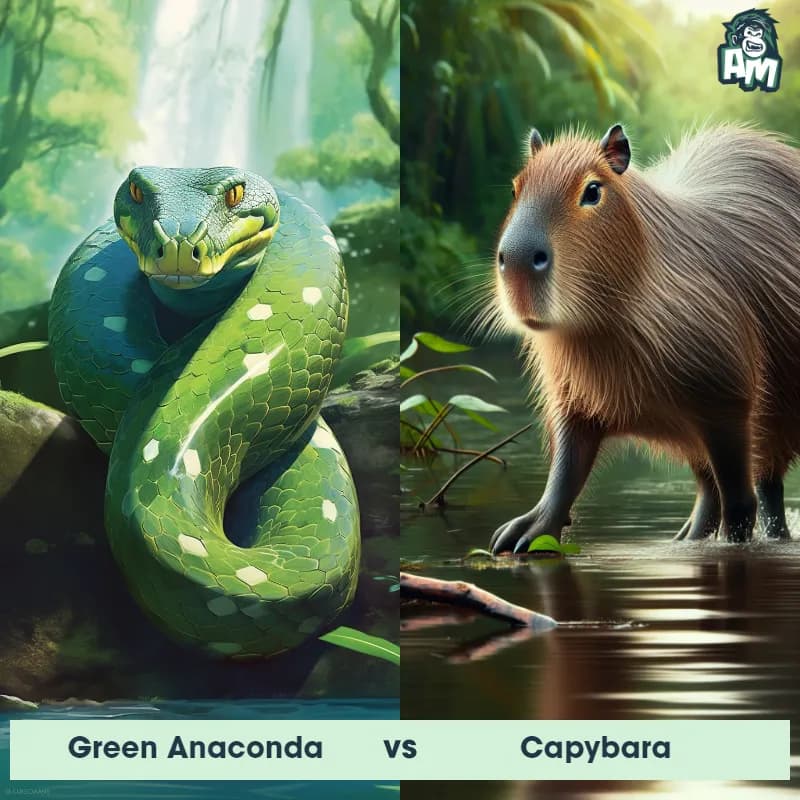Green Anaconda vs CapybaraSee Who Wins

Ladies and gentlemen, welcome to this thrilling matchup between a Green Anaconda and a Capybara! We are in for an intense battle between these two formidable creatures. Both are known for their strength and agility, so let's get ready to witness an extraordinary fight!
Contender 1: Green Anaconda
The Green Anaconda, also known as the common anaconda, is one of the largest and heaviest snakes in the world, with females growing up to 30 feet long and weighing over 500 pounds. They have a dark green coloration with black oval spots along their back and sides, and their eyes and nostrils are located on the top of their head, allowing them to breathe and see while mostly submerged in water. They are non-venomous constrictors, using their powerful muscles to squeeze their prey to death before swallowing them whole.
Fun Fact: Green Anacondas are excellent swimmers and can stay underwater for up to 10 minutes, using their nostrils to breathe while submerged.
Contender 2: Capybara
The Capybara, also known as Hydrochoerus hydrochaeris, is the largest rodent in the world. They are native to South America and are semi-aquatic creatures that spend a significant amount of time in water. Capybaras have a stocky, barrel-shaped body with a short head, small ears, and eyes positioned high on their head. They have webbed toes and can even close their ears and nostrils when fully submerged. Closely resembling a giant guinea pig, they have short, coarse fur that can vary in color from reddish-brown to gray, and their front teeth continue to grow throughout their lifespan.
Fun Fact: A fascinating fact about Capybaras is that they are highly social animals and are known to form close-knit family groups. They live in large herds of up to 100 individuals, comprising several adult males, females, and offspring. These herds have a hierarchical structure, with a dominant male leading the group and defending his territory and harem of females.
Matchup Stats
| Green Anaconda | Capybara | |
|---|---|---|
| Size | Up to 30 feet (9.1 meters) long | About 1.2 meters (3.9 feet) in length |
| Weight | Over 500 pounds (227 kilograms) | Around 50-65 kilograms (110-143 pounds) |
| Speed | Speed: 5 mph (8 km/hr) | 22 mph (35 km/h) |
| Key Strength | Powerful constricting muscles | Powerful jaws and strong legs for defense |
| Biggest Weakness | Slow movement on land | Less agile on land compared to in water |
Current Votes
Green Anaconda vs Capybara
See Who Wins
View More Matches
Looking For More?
Similar Matches
Scientific Stats
| Green Anaconda | Capybara | |
|---|---|---|
| Scientific Name | Eunectes murinus | Hydrochoerus hydrochaeris |
| Family | Boidae | Caviidae |
| Habitat | Freshwater rivers, swamps, and marshes | Semi-aquatic, found in wetlands and grassy areas near water bodies. |
| Geography | South America | Native to South America, specifically found in countries such as Brazil, Venezuela, Colombia, and Argentina |
| Diet | Carnivorous, feeding on a variety of prey including fish, birds, mammals, and reptiles | Herbivorous, primarily feeding on grasses and aquatic plants. |
| Lifespan | 10 years - 30 years | 10 years - 12 years |
Key Differences between Green Anaconda and Capybara
- Body Shape: The Green Anaconda has a long and slender body, tapering towards its tail, which aids in swimming and maneuvering through water. Conversely, the Capybara has a stout and bulky body with short limbs, more adapted for terrestrial locomotion.
- Behavior: The Green Anaconda is a solitary apex predator, known to ambush its prey in water, while the Capybara is a highly social animal, often found in large groups near water bodies, engaging in communal activities like grooming and vocalizations.
- Size: The Green Anaconda is one of the largest species of snake, capable of reaching lengths up to 30 feet, while the Capybara is the world's largest rodent, growing to about 4 feet in length and weighing up to 150 pounds.
- Tail: The Green Anaconda has a long, muscular tail with a prominent ridge on the ventral side, providing additional propulsion during swimming. On the other hand, the Capybara has a relatively short and thin tail, mainly used for communication and balance.
- Color: The Green Anaconda has a dark greenish-brown coloration with black blotches along its body, providing camouflage in its aquatic habitat. In contrast, the Capybara has a coarse, brownish-gray fur, often with a reddish tint, blending with its surroundings on land.
- Head Shape: The Green Anaconda possesses a triangular-shaped head, broader than the Capybara's head, enabling it to swallow large prey whole. The Capybara has a more rounded and elongated head, with small ears and eyes located on top, allowing it to stay partially submerged while feeding.
































